Practicing the CBSE Sample Papers for Class 12 Biology with Solutions Set 7 allows you to get rid of exam fear and be confident to appear for the exam.
CBSE Sample Papers for Class 12 Biology Set 7 with Solutions
Time: 3 Hours.
Max. Marks: 70
General Instructions:
- All questions are compulsory.
- The question paper has five sections and 33 questions. All questions are compulsory.
- Section-A has 16 questions of 1 mark each; Section- B has 5 questions of 2 marks each; Section- C has 7 questions of 3 marks each; Section- D has 2 case-based questions of A marks each; and Section- E has 3 questions of 5 marks each.
- There is no overall choice. However, internal choices have been provided in some questions. A student has to attempt only one of the alternatives in such questions.
- Wherever necessary, neat and properly labeled diagrams should be drawn.
Section – A (16 Marks)
Question 1.
Lac operon is an example of:
(a) Only positive regulation
(b) Only negative regulation
(c) Both positive and negative regulation
(d) Sometimes positive sometimes negative
Answer:
(c) Both positive and negative regulation
Explanation: The regulation of a lac operon by the repressor is known as negative regulation. At rare occasions, lac operons are also observed to be under the control of positive regulation. In negative regulation, the operon cannot transcribe the RNA polymerase enzyme.
Question 2.
Consider the following statement (s) related to the hotspot conservation.
I. Hot spots have the highest concentrations of unique biodiversity on the planet.
II. They are the places at the greatest risk of destruction.
III. The need for conservation in the hot spots regions is urgent to present a wave of species extinctions.Codes:
(a) Only I
(b) Only II
(c) Only III
(d) I, II and III
Answer:
(d) I, II and III
Explanation: Biodiversity hotspots are regions with high level of species richness and which are highly endemic. There are about 34 ecological hotspots in the world. Out of the 34 hotspots, 4 of them occur in India. They need to be conserved highly to avoid extinction.
Question 3.
Which of these acts as an inducer of the lac operon?
(a) Allolactose
(b) Lactose
(c) Galactose
(d) Glucose
Answer:
(a) Allolactose
Explanation: Repressors are the transcription factors that bind to operator gene and prevent the RNA polymerase from binding the downstream promoter genes and thus prevent their transcription. Inducer is a molecule that binds to repressor and cause conformational changes in repressor which in turn can no longer bind to operator. In presence of lactose, allolactose; an isomer of lactose, binds to the repressor and causes an allosteric shift. The altered repressor cannot bind to the operator allowing RNA polymerase to transcribe the lac genes. Thus, allolactose serve as inducer oflac operon.
Question 4.
Which of the following is not the criterion to qualify as a hotspot?
(a) It must contain at least 1,500 species of vascular plants (> 0.5% of the world’s total) as endemics.
(b) It has to have lost > 70% of its original native habitat.
(c) It must be the part of an underdeveloped country.
(d) None of the above.
Answer:
(c) It must be the part of an underdeveloped country.
Explanation: To qualify as a biodiversity hotspot, an area must meet the following criteria:
1. Contain at least1,500 species of vascular plants found nowhere else on Earth (known as “endemic species).
2. Have lost at least 70 percent of its primary native vegetation. Interspecific competition is a form of competition in which individuals of different species compete for the same resources in an ecosystem. And this is not a criteria for a area to be considered as a biodiversity hotspot.
![]()
Question 5.
Which of the following palindromic base sequence in DNA can be easily cut at about the middle by some particular restriction enzyme?
(a) 5’________GAATTC_____ 3′
3__________CTTAAG_____ 5′
(b) 5′ _______CACGTA_____ 3′
3’__________CTCAGT_____5′
(c) 5′ _______GATATG.______3′
3’__________CTACTA_______ 5′
Answer:
(a) 5’_________GAATTC_______3′
3’___________CTTAAG________5′
Explanation: from 5′ toThe3′ on palindromic one strands sequence and 5′ to 3’isona nucleic complementary acid sequence strand(DNAandorhenceRNA)can which be cuts easily. read same from 5′ to 3′ on its complementary strand and hence can be cut easily.
Question 6.
Plasmids are used as cloning vectors for which of the following reasons?
(a) Can be multiplied in culture.
(b) Self-replication in bacterial cells.
(c) Can be multiplied in laboratories with the help of enzymes.
(d) Replicate freely outside bacterial cells
Answer:
(b) Self-replication in bacterial cells.
Explanation: Plasmids are vectors for gene cloning because they self-replicate in bacterial cells.
Question 7.
Human insulin is being commercially produced from a transgenic species of:
(a) Mycobacterium
(b) Rhizobium
(c) Saccharomyces
(d) Escherichia
Answer:
(d) Escherichia
Explanation: Human insulin is produced from genetically engineered E. coli. By using genetic engineering or recombinant DNA technology, insulin-producing genes from human beings have been transferred into E. coli. bacteria, which produced insulin called ‘humulin’ for clinical use.
Question 8.
The following statements are drawn as conclusions from the graph given below.
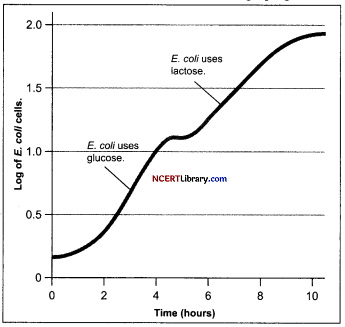
I. When grown in the presence of two substrates, E. coli uses the preferred substrate (in this case glucose) until it is depleted. Then, enzymes needed for the metabolism of the second substrate are expressed and growth resumes, although at a slower rate.
II. When grown in the presence of two substrates, E. coli uses both substrates equally.
III. When grown in the presence of two substrates, E. coli uses the less preferred substrate (in this case glucose) until it is depleted. Then, enzymes needed for the metabolism of the second substrate are expressed and growth resumes, although at a faster rate.
IV. When grown in the presence of two substrates, E. coli uses only one substrate.
Choose from below the correct alternative.
(a) Only I is true
(b) I, and IV are true
(c) III and II are true
(d) I and III are true
Answer:
(a) Only I is true
Explanation: When grown in the presence of two substrates, E. coli uses the preferred substrate (in this case glucose) until it is depleted. Then, enzymes needed for the metabolism of the second substrate are expressed and growth resumes, although at a slower rate.
Question 9.
The DNA fragments have sticky ends due to:
(a) Endonuclease
(b) Unpaired base
(c) Calcium ion
(d) Chlorine ion
Answer:
(b) Unpaired base
Explanation: DNA end or sticky end refers to the properties of the end of a molecule of DNA or a recombinant DNA molecule. The sticky ends form base pairs. Any two complementary cohesive ends can anneal, even those from two different organisms. This bondage is temporary however, and DNA ligase will eventually form a covalent bond between the sugar-phosphate residue of adjacent nucleotides to join the two molecules together.
Question 10.
Another name for down syndrome is:
(a) Trisomy 21
(b) Trisomy 13
(c) Diploid 21
(d) Trisomy 8
Answer:
(a) Trisomy 21
Explanation:body and Down brain syndrome develop,is which also referredcan cause to both as Trisomymental 21. This extra copy changes how the baby’s body and brain develop, which can cause both metal and physical extra challenges for the baby.
![]()
Question 11.
Genetically engineered bacteria are being employed for production of:
(a) Thyroxine
(b) Human insulin
(c) Cortisol
(d) Epinephrine
Answer:
(b) Human insulin
Explanation: Human insulin is made by genetically engineered microbes in a pure form. Genetically engineered bacteria are grown in large stainless steel fermentation vessels. The vessel contains all the nutrients needed for growth. When the fermentation is complete, the mixture containing the bacteria is harvested. The bacteria are filtered off and broken open to release the insulin they have produced. It is then purified and packaged into bottles for distribution.
Question 12.
Study the following list :
| List-I | List-II | ||
| A | Colony hybridisation | i. | Transfer of recombinant DNA in to a host cell |
| B | Gel electrophoresis | ii. | Selection of cells containing the desired gene |
| C | Gradient centrifugation | iii. | Separation of DNA fragments |
| D | Polymerase chain reaction | vi. | Purification of DNA |
| V. | Gene cloning | ||
(a) (A) – (iv), (B) – (v), (C) – (ii), (D) – (iii)
(b) (A) – (i), (B) – (ii), (C) – (iii), (D) – (iv)
(c) (A) – (ii), (B) – (iv), (C) – (v), (D) – (iii)
(d) (A) – (ii), (B) – (iii), (C) – (iv), (D) – (v)
Answer:
(d) (A) – (ii), (B) – (iii), (C) – (iv), (D) – (v)
Explanation: The cutting of DNA by restriction endonucleases results in fragments of DNA. These fragments are separated by technique known as gel-electrophoresis. In colony hybridisation, selected cells with desired genes are grown in culture. In gradient centrifugation, cells/DNA are spinned at very high speed to purify DNA. PCR is amplification or gene donning process used to amplify cell in large amount.
Question No. 13 to 16 consist of two statements – Assertion (A) and Reason (R). Answer these questions selecting the appropriate option given below:
(a) Both A and R are true and R is the correct explanation of A.
(b) Both A and R are true and R is not the correct explanation of A.
(c) A is true but R is false.
(d) A is false but R is true.
Question 13.
Assertion (A): An additional copy of chromosome number 21 causes down syndrome.
Reason (R): Aneuploidy occurs from an extra copy of chromosome.
Answer:
(a) Both A and R are true and R is the correct explanation of A.
Explanation: An additional copy of chromosome number 21 causes down syndrome because Aneuploidy occurs from an extra copy of chromosome. Thus both assertion and reason are true and reason is the correct explanation of the assertion.
Question 14.
Assertion (A): The community of an ecotone commonly contains the organisms ofeach of the overlapping communities and in addition the organisms which are restricted to the ecotone.
Reason (R): The tendency for increased variety and density at community junctions is known as the edge effect.
Answer:
(b) Both A and R are true and R is not the correct explanation of A.
Explanation: The community of an ecotone commonly contains the organism of each of the overlapping communities and in addition the organism which is restricted to the ecotone. The tendency for increased variety and density at community junctions is known as the edge effect. But the edge effect is not the reason for overlapping communities in the ecotone. Thus both assertion and reason are true but reason is not the correct explanation of the assertion.
Question 15.
Assertion (A): Test cross is the cross between the Fj progeny and either of the parent types.
Reason (R): Back cross is the cross between Fj progeny and the double recessive genotype.
Answer:
(d) A is false but R is true.
Explanation: A test cross is a cross involves the breeding of an individual with a phenotypically recessive individual, in order to determine the zygosity of the former by analyzing proportions of offspring phenotype and not the parent types. Back cross is the crossing of a hybrid with one of its parents or an individual genetically similar to its parent, in order to achieve offspring with a genetic identity which is closer to that of the parent. Thus assertion is false but reason is true.
![]()
Question 16.
The development of different functional structures from a common ancestral form is called adaptive radiation. Homologous organs show adaptive radiation. Darwin’s finches of the Galapagos Island had common ancestor but now have different types of modified beaks according to their food habits. Darwin differentiated thirteen species of finches and grouped them into six main types.
Assertion (A): Hugo de Vries said mutations cause speciation.
Reason (R): Mutations are slow changes
Answer:
(c) A is true but R is false.
Explanation: Hugo de Vries proposed the mutation theory. According to Hugo de Vries, single step large mutations (saltations) are responsible for the appearance of new variants that form entirely new species in a single generation. Hence, he believed that evolution is not a gradual process. Thus assertion is true but reason is false.
Section – B (10 Marks)
Question 17.
Given below is a schematic representation.
Analyse and answer the questions asked on the basis of it:
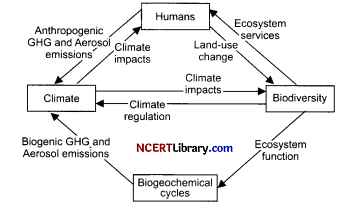
(a) What does the graph show about?
(b) Do you think that climate has an adverse impact on biodiversity as according to the graph?
(b) Yes, various anthropogenic processes and some ecosystem functions induce the changes in climatic patterns. This affects the biodiversity.
Answer:
(a) It explains the link between the biodiversity and other components of the ecosystem.
Question 18.
Answer the following questions by analyzing the figure below.

(a) Name the first transgenic cow. Which gene was introduced in this cow?
(b) How is ‘Rosie’ considered different from a normal cow? Explain.
Answer:
(a) Rosie was the first transgenic cow and it was produced in 1997. The gene for human protein a-lactalbumin was introduced in this cow. Thus, the cow could produce protein-enriched milk.
(b) Rosie cow was considered different from a normal cow as it produced human protein enriched milk. The milk contained ‘human alpha-lactalbumin’ and was nutritionally a more balanced product for human babies than a normal cow milk.
Question 19.
The sample under investigation was very less in quantity to give desired results. It was amplified using PCR. What are the correct steps of PCR which would give desired results?
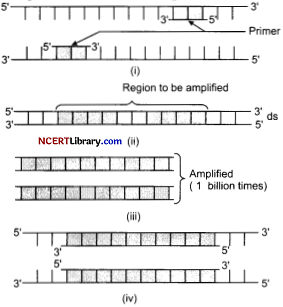
Answer:
The correct steps of PCR which would give desired results are:
\(\text { (ii) } \rightarrow \text { (i) } \rightarrow \text { (iv) } \rightarrow \text { (iii) }\)
The DNA sample to be amplified is taken and suitable primers are added which will bring polymerization of DNA resulting many copies at the end of cycle.
Question 20.
If a species of fish becomes extinct, all those parasites, specific to that fish also face extinction. Which of the major cause described as—the evil Quartets is being accounted?
Answer:
This is an example of co-extinctions, wherein when a species becomes extinct, the plant and animal species linked or associated with it also become extinct. For example, in case of a coevolved plant pollinator mutualism where extinction of one invariably leads to the extinction of other.
Section – C (21 Marks)
Question 21.
What are the areas of biotechnology that still has a scope for further research?
OR
How is mammalian insulin synthesized?
Answer:
Biotechnology has a scope in the critical research areas as:
1. In providing the best catalyst in the form of an improved organism usually a microbe or a pure enzyme.
2. Generating the optimal conditions for catalyst to act upon.
3. Downstream processing so as to purify the protein or an organic compound produced.
OR
The mammalian insulin is synthesized as a prohormone that needs to be processed before it becomes a fully mature and functional hormone. The immature insulin has an extra stretch called C peptide.

Given below are example of some of the activities performed by animals. Categorise these activities into the appropriate kind of the organismic response (L, M and N) as shown in the graph with reasons.
(a) In summers we sweat profusely.
(b) Sometimes desert lizards bask in the sun and sometimes they move into shade.
Answer:
L: Conformers and M: Regulators
(a) M/ Regulators: To regulate the body temperature. Some organisms are able to maintain homeostasis by physiological means which ensures constant body temperature, constant osmotic concentration, etc.
(b) L/ Conformers: Their body temperature changes with the ambient temperature .So to keep their body temperature constant by behavioural response for coping with variations in environment.
![]()
Question 23.
(a) Why the middle piece of sperm contains the mitochondria?
(b) Give the role of Zona pelslucida.
Answer:
(a) The middle-piece of sperm cells contains lots of mitochondria to provide the sperm with enough energy when moving forward inside the fallopian tube. They provide energy for motility.
(b) Zona pellucida is a middle, thick, transparent and non-cellular layer. It is secreted partly by follicular cells and partly by the oocyte. It consists of glycoprotein that protects the entry of sperm
Question 24.
(a) What do ‘Y and ‘B’ stand for in ‘YAC’ and ‘BAC’ used in Human Genome Project (HGP) ? Mention their role in the project.
(b) Write the percentage of the total human genome that codes for proteins and the percentage of discovered genes whose functions are known as observed during HGP.
(c) Expand ‘SNPs’ identified by scientists in HGP
OR
Compare in any three ways the chromosomal theory of inheritance as proposed by Sutton and Bovary with that of experimental results on pea plant presented by Mendel.
Answer:
(a) Y in YAC stands for yeast and B in BAC stands for bacteria they are specialised cloning vectors used in human genome project for cloning or amplification of foreign DNA fragments.
(b) Less than 2% of total genome codes for proteins in humans and around 50% of gene functions are known during HGP.
(c) SNP—Single Nucleotide Polymorphism
OR
| S. No. | Sutton and Boveri | Mendel |
| (i) | Chromosomes occurs pairs. | Factor occur in pairs. |
| (ii) | Chromosomes segregate at the time of gamete formation such that only one of each pair is transmitted to a gamete. | Factors segregate at gamete formation only one of each pair is transmitted to a gamete. |
| (iii) | Independent pairs of chromosomes segregate independent of other pairs. | One pair of factors segregate independ of another pair. |
Question 25.
Define floes and state their importance in biological treatment of waste water.
Answer:
Floes are masses of bacteria associated with fungal filaments to form mesh like structure. Floes digest and separate most of the organic material from the sludge or waste water. Thus, floe helps in reducing the BOD (Biochemical Oxygen Demand) of the effluent. This floe can be used as inoculum in further treatment of sludge as well as source of biogas and manure. Floe also called as activated sludge.
Question 26.
Your friend has been detected with a tumour. After consulting an oncologist he was found positive for cancer. List any three causes that may have induced cancer in your friend’s body.
Answer:
Cancer is one of the most deadly disease of human being. The major cause behind cancerous growth is:
1. Overconsumption of any cancer inducing carcinogenic or oncogenic agent. For example Lathyrus (Khesari dal).
2. Over smoking and alcoholism along with dietary factors.
3. Chemical and environmental factors.
4. Susceptibility to cancer depends upon familial factors
Question 27.
What is the DNA fingerprinting based on ? How are entities of human body like blood, skin and hair follicle important in forensics?
Answer:
The higher degree of polymorphism shown by the DNA sequences forms the basis of DNA fingerprinting. The technique was developed in 1984 by British geneticist Alec Jeffreys, after he noticed that certain sequences of highly variable DNA (known as minisatellites), which do not contribute to the functions of genes, are repeated within genes.
Jeffreys recognised that each individual has a unique pattern of minisatellites (the only exceptions being multiple individuals from a single zygote, such as identical twins). The wide application of the concept is in the forensic science. The entities of human body, such as blood, bone, hair follicle etc., show same degree of polymorphism and acts as identification tool in the field of forensic science.
Question 28.
Below given are some GMO’s, give the unique characteristic feature of each:
(a) Golden Rice
(b) Cattles (cow, sheep)
(c) Pig
(b) Therapeutic human proteins in their milk.
(c) Organ transplantation with the risk of immune response.
Answer:
(a) Vitamin A rich.
Section – D (8 Marks)
Questions No. 29 and 30 are case based questions. Each question has subparts with internal choice in one subpart.
Question 29.
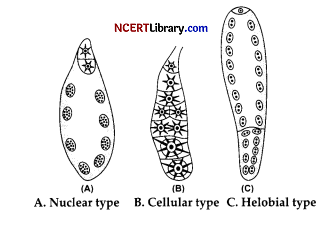
(a) Explain the types of endosperm in the given figure A, B, and C.
(b) Explain the different types of endosperms in angiosperms.
Answer:
(a) A-Nuclear type B-Cellular type C-Helobial type
(b) The different types of Endosperms found in angiosperms are :
(i) Nuclear Endosperms: The endosperm nucleus gives rise to a number of free nuclei which stay in the peripheral layer. A large central vacuole appears in the embryo sac. Cell wall formation takes place from the periphery towards the centre leading to the formation of cellular endosperm. Examples : Maize, Wheat, Rice, Sunflower, coconut, etc.
(ii) Cellular Endosperm: Division of the primary endosperm nucleus is immediately followed by cell wall formation so that the endosperm is cellular from the beginning.
Examples : Balsam, Datura, Petunia, Villarsia, etc.
(iii) Helobial Endosperm: A partition wall develops between the two nuclei resulting in the first division of the endosperm. Endosperm development is intermediate between the free nuclear and cellular type. A partition wall develops between the two nuclei resulting in the first division of the endosperm. Examples : Asphodelus, Echium, etc.
![]()
Question 30.
Following is the graph given below. Answer the questions based upon it:
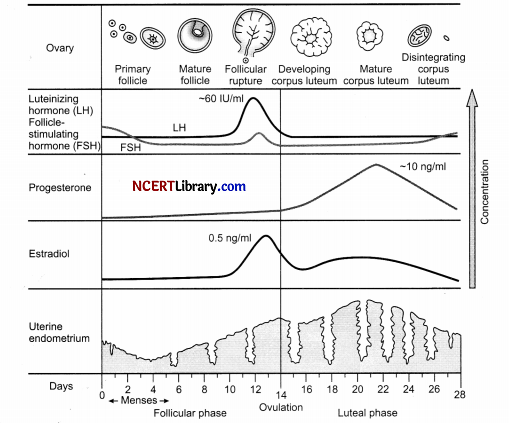
(a) Name the hormone that is responsible for follicular rupture.
(b) The concentration of estradiol rises and goes down between which two stages?
(c) When is the concentration of progesterone at its peak?
OR
(c) On which day does the ovulation occur?
Answer:
(a) For the follicular rupturing, the high concentration of LH is responsible.
(b) It rises and goes down between the follicular rupturing and developing corpus luteum.
(c) The progesterone concentration goes high when the developing corpus luteum matures.
OR
(c) Ovulation occurs on the 14th day of menstrual cycle.
Section – E (15 Marks)
Question 31.
The following figure shows a foetus within the uterus. On the basis of the given figure, answer the questions that follow:
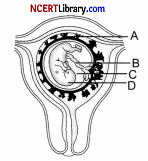
(a) In the above figure, choose and name the correct part (A, B, C or D) that act as a temporary endocrine gland and substantiate your answer. Why is it also called the functional junction?
(b) Mention the role of B in the development of the embryo.
(c) Name the fluid surrounding the developing embryo. How is it misused for sex-determination?
OR
(a) Name the hormones secreted and write their functions:
(i) By corpus luteum and placenta (any two).
(ii) During follicular phase and parturition.
(b) Name the stages in a human female where:
(i) Corpus luteum and placenta co-exist.
(ii) Corpus luteum temporarily ceases to exist
Answer:
(a) Part labeled A Placenta. It functions as an endocrine tissue as it produces several hormones like estrogens, human chorionic gonadotropin (hCG), human placental lactogen (hPL), progestogens, etc. It is also called the functional junction because it enables the supply of oxygen and nutrients to the embryo and removes carbon dioxide and excretory or waste materials produced by the embryo.
(b) The umbilical cord (also called the navel string, birth cord or funiculus umbilicalis) is a conduit between the developing embryo or fetus and the placenta, which helps in the transport of substances to and from the embryo.
(c) Amniotic fluid test or Amniocentesis is used for prenatal diagnosis and used for foetal diagnosis. Foetal sex can be determined by examining cells from the amniotic fluid by looking for Barr bodies and female sex chromosome.
OR
(a) (i) Corpus Luteum secretes progesterone which is essential for maintenance of endometrium. Placenta secretes hCG which stimulates and maintains corpus luteum for secretion of progesterone. hPL is helpfulinsupplying energy to the growing foetus. Estrogen supports foetal growth and brings about metabolic changes in mother. Progesterone helps in maintenance of pregnancy.
(ii) During Follicular Phase: FSH stimulates follicular development.
During Parturition: Oxytocin causes stronger uterine contraction.
(b) (i) They co-exist during pregnancy or gestation.
(ii) It happens during menstruation.
![]()
Question 32.
Evaluate the suitability of DNA and RNA as genetic material and justify the suitability of the one that is preferred as an ideal genetic material
OR
Explain the mechanism of DNA replication as suggested by Watson and Crick.
Answer:
Evaluation of DNA and RNA on the basis of the properties of the genetic material:
1. Genetic material should be able to generate its copy (Replication): As per the rule of base pairing and complementarity, both the nucleic acids (DNA and RNA) have the ability to direct their duplications.
2. It should be chemically and structurally stable throughout the different stages of life cycle, age or with change in the physiology of the organism. The presence of 2′-OH group and uracil make RNA more reactive and structurally less stable than DNA. The extra oxygen and hydrogen atoms in RNA leave it prone to hydrolysis, a chemical reaction that effectively breaks the RNA molecule in half. Thus, DNA is a better genetic material than RNA.
3. RNA can directly code for the synthesis of proteins, so it can easily express the characters. But, DNA is dependent on RNA for synthesis of proteins. Genetic material should be able to express itself in the form of ‘Mendelian Characters’:
4. As it is important that genetic material should offer slow changes (mutation), required for evolution: Both DNA and RNA are able to mutate. RNA being unstable, mutates at a faster rate. This is the reason why viruses having RNA genome and having shorter life span mutate and evolve faster. All the discussed points indicates that both RNA and DNA can function as genetic material, but DNA being more stable is preferred for storage of genetic information
OR
Watson and Crick introduced the second major discovery brought about by an understanding of DNA’s structure, the mechanism by which DNA replicates itself:
1. The two strands of DNA would separate and act as a template for the synthesis of new complementary strands. Showing semi-conservative replication of DNA (Each copy contains one original strand and one newly-synthesised strand)
2. Enzymes catalyze the synthesis of new DNA in the 5′ to 3′ direction, using the original strands as models, or templates, for the complementary strands. The main enzyme is referred to as DNA-dependent DNA polymerase, it uses a DNA template to catalyse the polymerization of deoxynucleotides.
3. Deoxyribonucleoside triphosphates serve dual purposes. In addition to acting as substrates, they fulfill excessive energy requirements by providing energy for the polymerization reactions.
4. DNA molecule is long and due to very high energy requirement, since the two strands of DNA cannot be separated in its entire length, the replication occurs within a small opening of the DNA helix, referred to as the replication fork.
5. The DNA-dependent DNA polymerases catalyse polymerization in 5′ to 3’direction. Consequently, on the template with polarity 3′ to 5′, the replication is continuous, while on the other template with polarity 5’to 3′), replication is discontinuous. The discontinuously synthesised fragments are later joined by the enzyme DNA ligase.
Because of the specificity of base pairing and the proofreading activity of the enzyme that synthesises new DNA, less than one error in 100 million is incorporated into the new DNA strands. Thus genetic information is passed accurately on to the next generation.
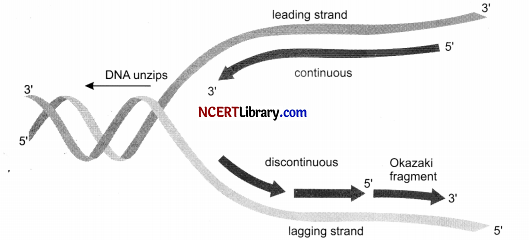
1. The DNA polymerases on their own cannot initiate the process of replication at a specific site.
2. In E. coli DNA the replication originates, from a definite region such regions are termed as origin of replication.
3. In eukaryotes, the replication of DNA takes place during S-phase of the cell-cycle.
4. The replication of DNA and cell – division cycle should be extremely coordinated. A failure in cell division after DNA replication can cause polyploidy
![]()
Question 33.
(a) Name the causative agents of pneumonia and common cold.
(b) How do these differ in their symptoms?
(c) Mention two symptoms common to both.
OR
During a school trip to ‘Rohtang Pass’, one of your classmates suddenly developed ‘altitude sickness’. But, she recovered after sometime.
(a) Mention one symptom to diagnose the sickness.
(b) What caused the sickness?
(c) How could she recover by herself after some time ?
Answer:
(a) Streptococcus pneumoniae and Haemophilus influenzae are responsible for the disease pneumonia and common cold respectively.
(b) The symptoms of pneumonia include fever, chills, cough and headache. The common cold is
characterized by nasal congestion and discharge, tiredness, etc., which usually lasts for 3-7 days.
(c) Cough and headache are the symptoms common in both.
OR
(a) The symptoms may be nausea, fatigue or heart palpitation.
(b) The sickness was caused due to low atmospheric pressure which prevails at high altitude. The body does not get enough oxygen.
(c) The body compensates low oxygen availability by increasing RBC production, decreasing the binding affinity of haemoglobin and by increasing breathing rate.